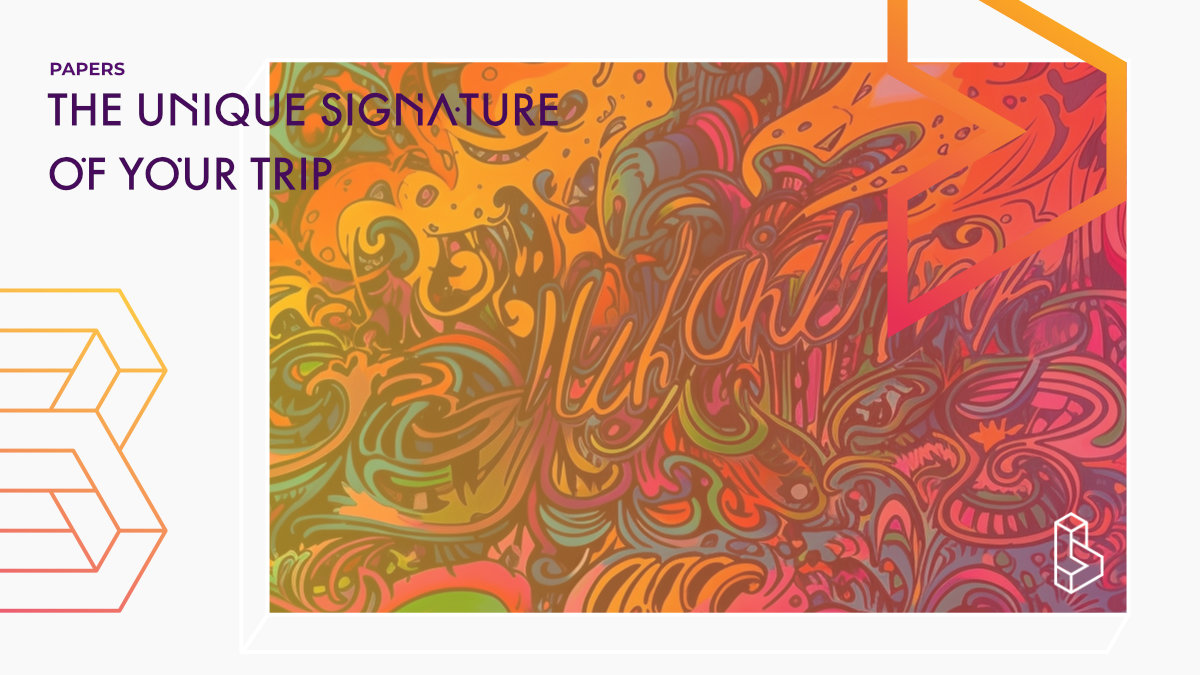This re-analysis (n=48) of a double-blind study on the effects of psilocybin (12mg/70kg, n=21) finds that function connectomes (FCs) become more idiosyncratic, especially in the default-mode network (DMN). Looking specifically at the DMN, the researchers find reduced within-DMN activity and more connectivity with attentional systems.
Abstract of The unique neural signature of your trip
“The emerging neuroscientific frontier of brain fingerprinting has recently established that human functional connectomes (FCs) exhibit fingerprint like idiosyncratic features, which map onto heterogeneously distributed behavioural traits. Here we harness brain fingerprinting tools to extract FC features that predict subjective drug experience induced by the psychedelic psilocybin. Specifically, in neuroimaging data of healthy volunteers under the acute influence of psilocybin or a placebo, we show that, post-psilocybin administration, FCs become more idiosyncratic due to greater inter-subject dissimilarity. Moreover, whereas in placebo subjects idiosyncratic features are primarily found in the frontoparietal network, in psilocybin subjects they concentrate in the default-mode network (DMN). Crucially, isolating the latter revealed an FC pattern that predicts subjective psilocybin experience and is characterised by reduced within-DMN and DMN-limbic connectivity, as well as increased connectivity between the DMN and attentional systems. Overall, these results contribute to bridging the gap between psilocybin-mediated effects on brain and behaviour, while demonstrating the value of a brain-fingerprinting approach to pharmacological neuroimaging.“
Authors: Hanna M. Tolle, Juan Carlos Farah, Pablo Mallaroni, Natasha L. Mason, Johannes G. Ramaekers & Enrico Amico
Summary of The unique neural signature of your trip
Psychedelic drugs such as LSD, DMT, and psilocybin have been rediscovered as effective and safe treatments for various psychiatric disorders. The characteristic mind-altering effects of psychedelics are primarily mediated via agonism of the serotonin receptor 5-HT2AR. However, how 5-HT2AR agonism affects whole-brain dynamics to induce the experienced ASC is still a subject of ongoing research.
It has been proposed that psychedelics alter the brain’s functional hierarchy by modulating activity in higher-level cortical networks and increasing functional connectivity between lower-level systems. Network-based analyses of neuroimaging data have advanced our understanding of the group-level effect of psychedelics on the brain.
The subjective acute-drug experience influences the long-term benefits of psilocybin treatment, and the FC reconfigurations in a subject’s brain are likely to be idiosyncratic, just like the pattern of furrows and ridges that defines an individual’s fingerprint. This study applied brain-fingerprinting tools to 7-Tesla fMRI data of 46 healthy volunteers undergoing treatment with 21mg/70kg psilocybin or a placebo, to examine whether idiosyncratic FC patterns allow for improved predictions of subjective psilocybin experience.
Find this paper
https://doi.org/10.1162/netn_a_00349
Open Access | Google Scholar | Backup | 🕊
Cite this paper (APA)
Tolle, H. M., Farah, J. C., Mallaroni, P., Mason, N. L., Ramaekers, J. G., & Amico, E. (2023). The unique neural signature of your trip: Functional connectome fingerprints of subjective psilocybin experience. Network Neuroscience, 1-54.
Study details
Compounds studied
Psilocybin
Topics studied
Neuroscience
Study characteristics
Original Re-analysis
Placebo-Controlled
Double-Blind
Randomized
Re-analysis
Participants
48
Humans
Authors
Authors associated with this publication with profiles on Blossom
Natasha MasonNatasha Mason is interested in elucidating the neurobiological and cognitive mechanisms of (psychedelic) drugs by utilizing multimodal study designs, with a particular focus on substances that may hold therapeutic value.
Johannes Ramaekers
Johannes Ramaekers is a professor at Maastricht University his work focuses on behavioral toxicology of drugs and combines methods from psychopharmacology, forensic toxicology and neuroscience to determine drug-induced changes in human performance. Some of this research is done with DMT.
Institutes
Institutes associated with this publication
Maastricht UniversityMaastricht University is host to the psychopharmacology department (Psychopharmacology in Maastricht) where various researchers are investigating the effects of psychedelics.
Compound Details
The psychedelics given at which dose and how many times
Psilocybin 12 mg | 1xLinked Research Papers
Notable research papers that build on or are influenced by this paper
Me, myself, bye: regional alterations in glutamate and the experience of ego dissolution with psilocybinThis brain imaging study (n=60) with psilocybin (12mg/70kg) investigated the changes in glutamate levels in various brain areas and found that lower levels in hippocampal glutamate were correlated with positively experienced ego dissolution. Higher levels of medial prefrontal cortical glutamate correlated with negatively experienced ego dissolution.
Spontaneous and deliberate creative cognition during and after psilocybin exposure
This double-blind, placebo-controlled, between-subjects study (n=60) investigated the effects of psilocybin (11.9 mg/70kg) on creativity in healthy participants, with respect to acute and persisting changes in convergent and divergent thinking in relation to restructuralization of Default Mode Network (DMN) connectivity. Although subjects felt more insightful under the acute psychedelic state, their ability to generate ideas and associations in a goal-directed manner was impaired. However, 7 days after psilocybin administration, participants generated a higher quantity of novel ideas for uses of an everyday object. Decreased integrity of the DMN under the acute state was the strongest predictor of subjective insightfulness, acute decrease in scores of originality, and a long-term increase in the generation of novel ideas.
Linked Clinical Trial
Psilocybin as a tool for enhancing cognitive flexibilityThe study will assess drug-induced change in performance in divergent thinking and goal-directed behaviour when comparing psilocybin to placebo, before and after an induction of stress. Additional study parameters include frontal-subcortical connectivity alterations and neurotransmission of glutamate and GABA between treatment conditions, as well as subjective questionnaires, pharmacokinetics, and cortisol.

